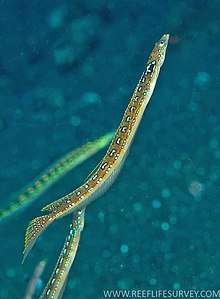Trichonotus elegans
Trichonotus elegans, the long-rayed sand-diver, is a species of marine perciform fishes. It is found throughout the Indo-West Pacific.[3] This species occurs in coastal reef slopes and deep outer reef lagoons where the channels create currents. It is a sociable species which is found in large groups each including a number of larger males. Its preferred habitat is substrates made up of sand and coral rubble). It is normally seen sitting still in the water column above sandy slopes. Their social grouping normally consist of a single male and a harem of around twelve females. Species in the genus Trichonotus are protogynous hermaphrodites.[4] They are usually buried when the current is slack.[1]
| Trichonotus elegans | |
|---|---|
 | |
| Scientific classification | |
| Kingdom: | Animalia |
| Phylum: | Chordata |
| Class: | Actinopterygii |
| Order: | Trachiniformes |
| Family: | Trichonotidae |
| Genus: | Trichonotus |
| Species: | T. elegans |
| Binomial name | |
| Trichonotus elegans | |
| Synonyms | |
|
Terichonotus elegans Shimada & Yoshino, 1984 | |
References
- Carpenter, K.E. & Smith-Vaniz, W.F. (2016). "Trichonotus elegans (errata version published in 2017)". The IUCN Red List of Threatened Species. 2016: e.T69739558A115472765. doi:10.2305/IUCN.UK.2016-3.RLTS.T69739558A69742679.en.
- Shimada, K. and T. Yoshino, 1984. A new trichonotid fish from the Yaeyama Islands, Okinawa Prefecture, Japan. Jap. J. Ichthyol. 31(1), pages 15-22
- Froese, Rainer and Pauly, Daniel, eds. (2018). "Trichonotus elegans" in FishBase. February 2018 version.
- Kusen, J.D.; Nakagawa, K.; Yogo, Y. & Nakazono, A. (1991). "Protogynous hermaphroditism in the sand diver Trichonotus filamentosus". Nippon Suisan Gakkaishi. 57 (1): 35–40. doi:10.2331/suisan.57.35.
This article is issued from Wikipedia. The text is licensed under Creative Commons - Attribution - Sharealike. Additional terms may apply for the media files.
